Unit 10 He has two feet. 课件(33张PPT)
文档属性
| 名称 | Unit 10 He has two feet. 课件(33张PPT) | 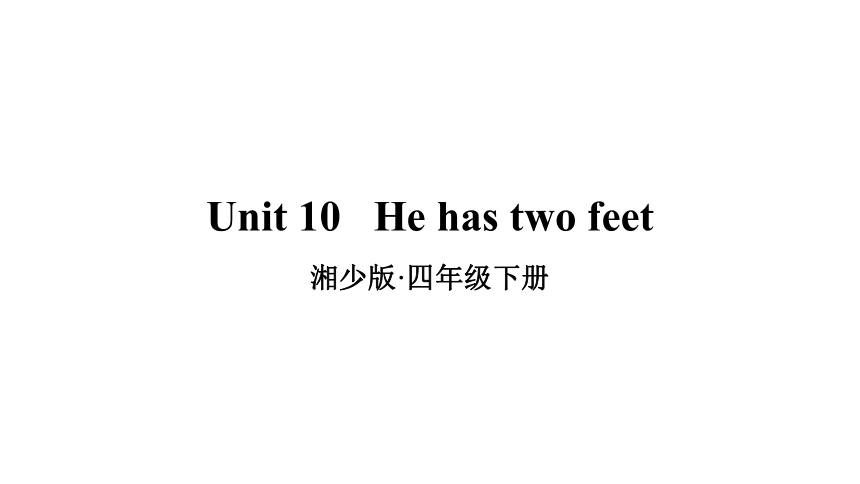 | |
| 格式 | zip | ||
| 文件大小 | 1.8MB | ||
| 资源类型 | 教案 | ||
| 版本资源 | 湘少版 | ||
| 科目 | 英语 | ||
| 更新时间 | 2020-05-28 16:36:11 | ||
图片预览

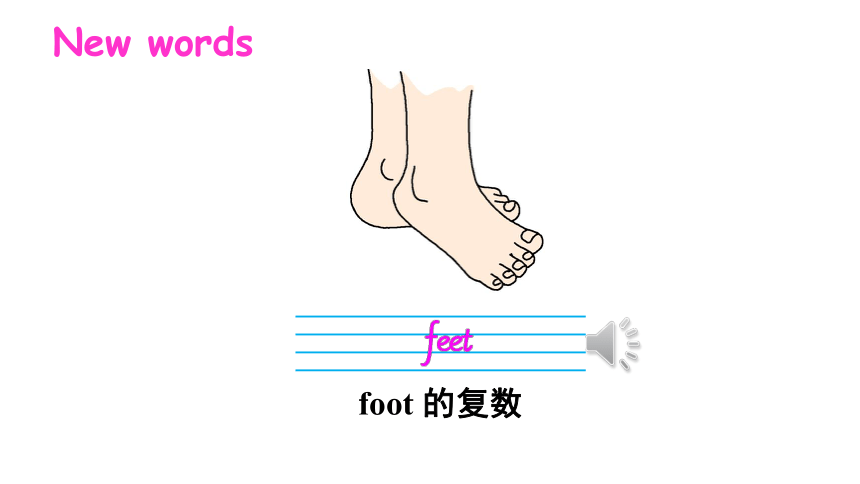
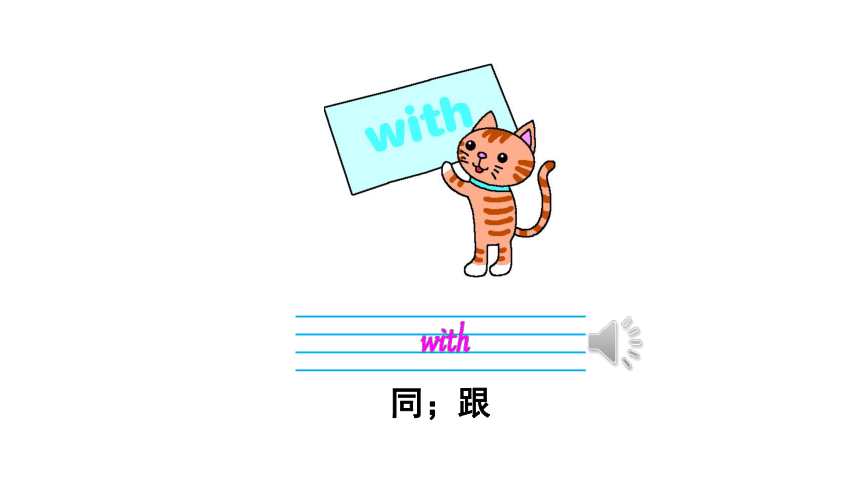

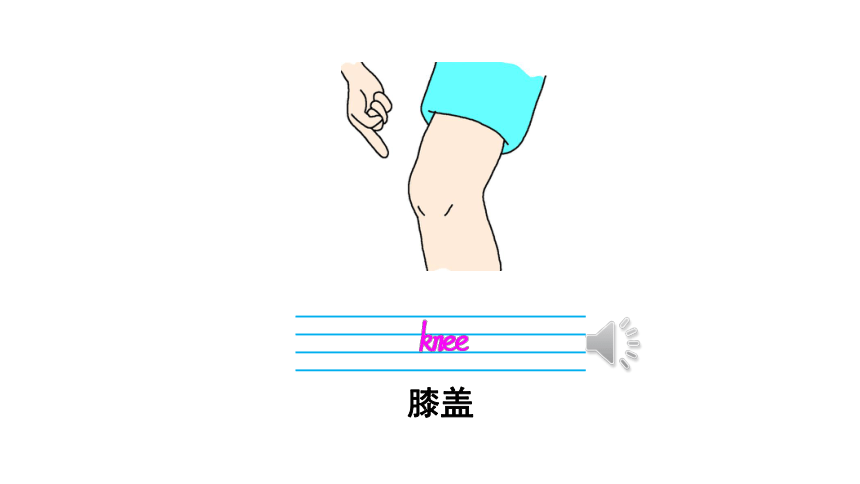
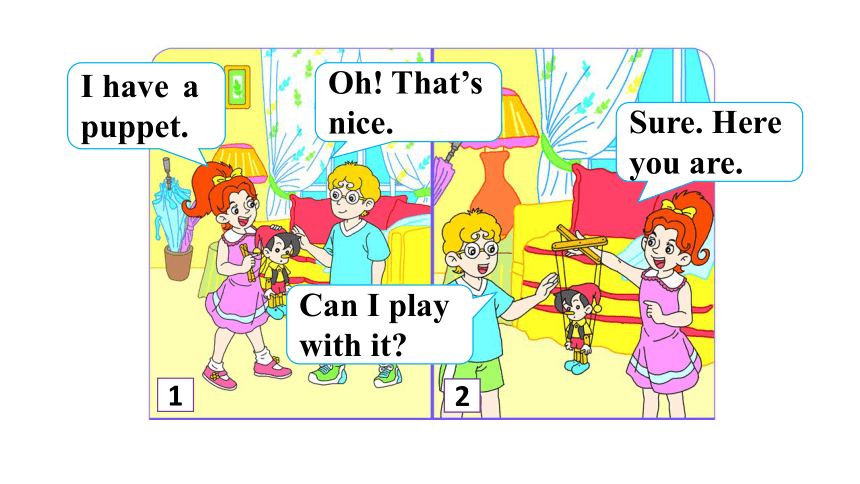

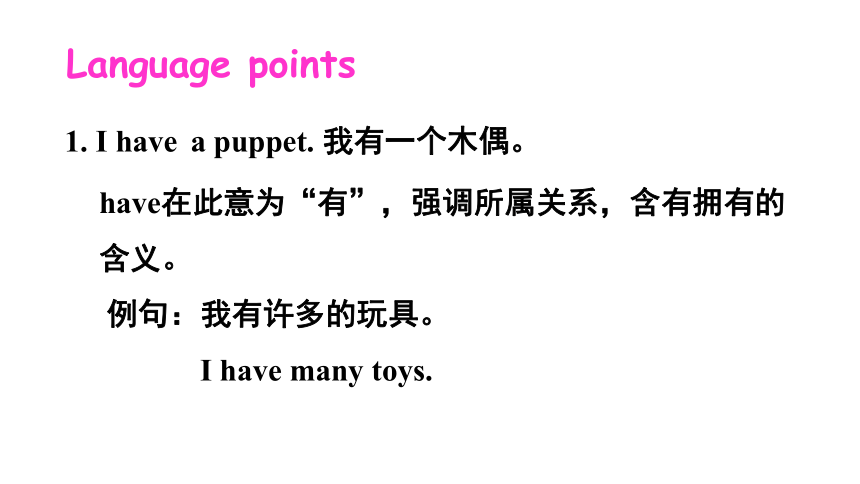
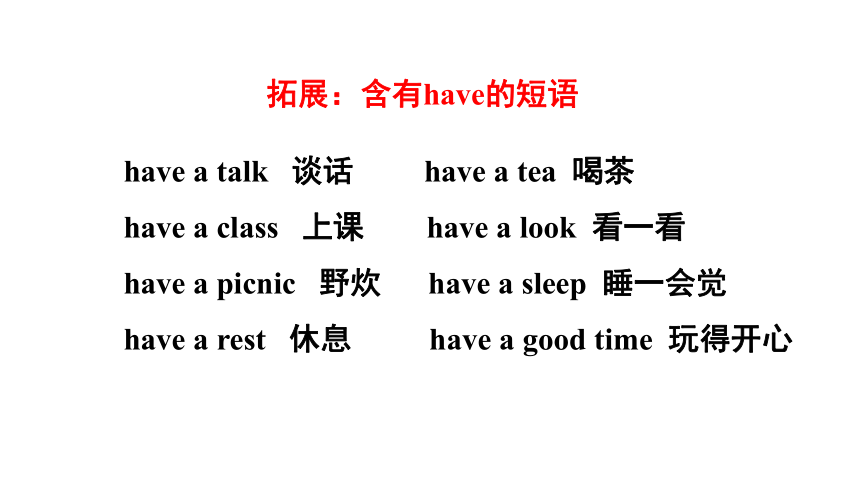
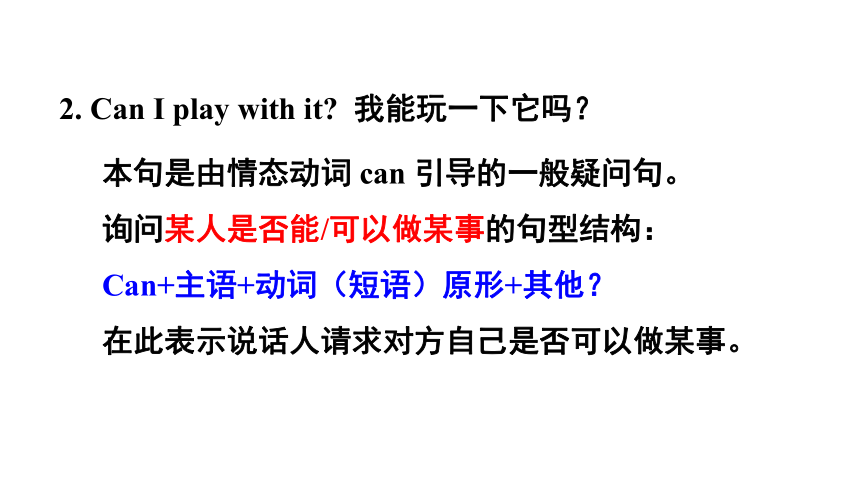
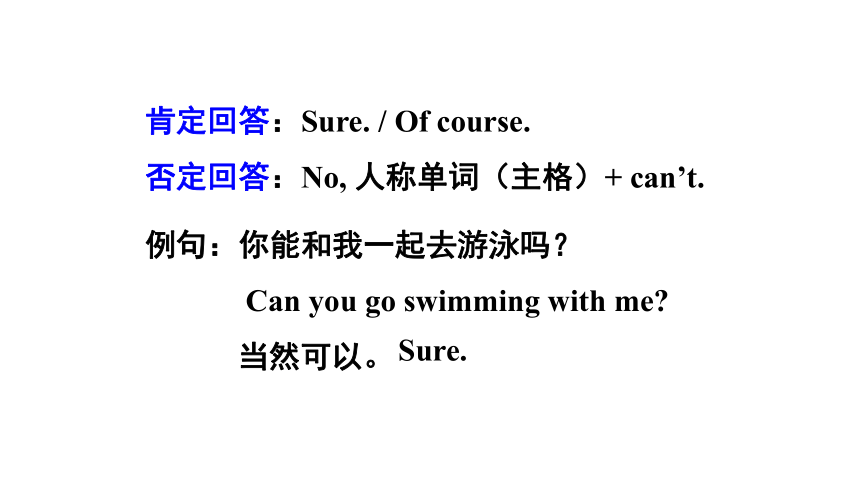

文档简介
(共33张PPT)
Unit
10
He
has
two
feet
湘少版·四年级下册
foot
的复数
New
words
同;跟
手指
膝盖
I
have
a
puppet.
Oh!
That’s
nice.
1
2
Can
I
play
with
it?
Sure.
Here
you
are.
3
4
5
He
can
walk.
Language
points
1.
I
have
a
puppet.
我有一个木偶。
have在此意为“有”,强调所属关系,含有拥有的含义。
例句:我有许多的玩具。
I
have
many
toys.
have
a
talk
谈话
have
a
tea
喝茶
have
a
class
上课
have
a
look
看一看
have
a
picnic
野炊
have
a
sleep
睡一会觉
have
a
rest
休息
have
a
good
time
玩得开心
拓展:含有have的短语
2.
Can
I
play
with
it?
我能玩一下它吗?
本句是由情态动词
can
引导的一般疑问句。
询问某人是否能/可以做某事的句型结构:
Can+主语+动词(短语)原形+其他?
在此表示说话人请求对方自己是否可以做某事。
肯定回答:Sure.
/
Of
course.
否定回答:No,
人称单词(主格)+
can’t.
例句:你能和我一起去游泳吗?
Can
you
go
swimming
with
me?
当然可以。
Sure.
3.
He
has
two
hands.
他有两只手。
本句是描述某人身体部位的数量的句子。
句型结构:主语+have/has+数词+身体部位的名词.
例句:她有十根手指。
She
has
ten
fingers.
4.
He
can
walk.
他会走。
这是一个陈述句。
句式结构:主语+can+动词原形+其他.
用来介绍某人能做什么。
例句:这个男孩会做什么?
他会打扫卧室。
What
can
the
boy
do?
He
can
clean
the
bedroom.
拓展:表示某人不能做某事,通常用句型:
主语+can’t+动词原形+其他.
例句:我不会跳舞。
I
can’t
dance.
foot
feet
脚
脚
finger
手指
leg
knee
腿
膝盖
feet
脚
Language
points
feet
是foot的复数形式,属于名词复数的不规则变化。
名词分为可数名词和不可数名词两种。
可数名词通常能一个一个的数,所以有单数和复数两种形式。不可数名词,顾名思义,不能一个一个的数,所以没有复数形式。可数名词单数变复数时,有一些是规则的,有规律可循;有一些是不规则的。
(1)规则的名词复数的变化规律:
一般情况下,直接在名词后面加s。
dog
→
dogs(狗);
window
→
windows(窗户)
以s,x,sh,ch等结尾的名词,要在词尾加es。
bus
→
buses(公共汽车);
box
→
boxes(箱子)
以“辅音字母+y”结尾的名词,要把y变成i,再加es。
library
→
libraries(图书馆);strawberry
→strawberries
(草莓)
以o结尾的名词大多数直接加s。
zoo
→
zoos(动物园)
(tomato,
potato除外)
以f或fe结尾的名词,变f或fe为v,再加es。
knife
→
knives(小刀);
leaf
→
leaves(叶子)
①单复数相同,例如:sheep
→sheep(绵羊);
fish
→fish(鱼)
②元音字母变化的,如:man
→men(男人);
woman
→
women(女人);foot
→feet(脚);
tooth
→teeth(牙齿)
③词尾发生变化的,如:child
→children(孩子)
(2)常见的不规则名词的复数形式:
Let’s
act
Work
in
pairs.
Take
turns
to
tell
your
partner
to
draw
a
funny
puppet.
Draw
a
big
head.
This
is
my
puppet.
How
many
teeth
do
you
have,
Dino?
1
2
3
I
have
sixteen
teeth.
Let
me
show
you.
AHH!
Your
teeth
are
terrible.
I’m
sorry,
Tim.
1.
How
many
teeth
do
you
have,
Dino?
迪诺,你有多少颗牙齿?
(1)此句型用于询问对方所拥有的物品的数量.
句型结构:How
many+可数名词复数+do
you
have?
答语:I
have+数词+可数名词.
(2)how
many是一个固定的疑问词组。
常用来对可数名词的数量进行提问。意为“多少”。
例句:你有多少本书?
How
many
books
do
you
have?
我有两本书。
I
have
two
books.
how
much
多少(钱)
how
far
多远
how
long
多长时间
how
often
多久
how
about
怎么样
拓展:与how有关的短语
例句:你有多少根手指?
How
many
fingers
do
you
have?
你有多少水?
How
much
water
do
you
have?
2.
Let
me
show
you.
让我给你看看。
这是由let引导的祈使句,它表示建议、请求、命令或劝告等,通常省略主语。
let
sb.
do
sth.
让某人做某事
注意:let的后面接的代词宾语是us时,
let
us通常会
缩写为let’s。
Let’s
read
and
write
Anne:
I
have
a
good
friend.
He
has
two
long
legs
and
two
big
feet.
He
can
walk
and
jump.
Amy:
I
have
a
good
friend.
He
has
two
feet.
He
can
fly.
Tom:
I
have
a
good
friend.
She
has
two
big
eyes.
She
has
two
big
ears.
She
can
run
and
jump.
1.This
is
Anne’s
friend.
_______________.
2.This
is
_________________________.
3.
This
is
_________________________.
Write
about
Anne’s,
Amy’s
and
Tom’s
friends.
He
is
a
puppet
Amy’s
friend.
He
is
a
bird
Tom’s
friend.
She
is
a
dog.
Green,
green
grass.
See
how
it
grows.
Long
green
grass,
Grows
on
the
ground.
gr
Let’s
have
fun
One,
two,
Tie
my
shoe.
Three,
four,
Knock
on
the
door.
Let’s
rhyme.
Five,
six,
Pick
up
sticks.
Seven,
eight,
Oh
dear,
we’re
late.
Nine,
ten,
Start
again.
再
见
Unit
10
He
has
two
feet
湘少版·四年级下册
foot
的复数
New
words
同;跟
手指
膝盖
I
have
a
puppet.
Oh!
That’s
nice.
1
2
Can
I
play
with
it?
Sure.
Here
you
are.
3
4
5
He
can
walk.
Language
points
1.
I
have
a
puppet.
我有一个木偶。
have在此意为“有”,强调所属关系,含有拥有的含义。
例句:我有许多的玩具。
I
have
many
toys.
have
a
talk
谈话
have
a
tea
喝茶
have
a
class
上课
have
a
look
看一看
have
a
picnic
野炊
have
a
sleep
睡一会觉
have
a
rest
休息
have
a
good
time
玩得开心
拓展:含有have的短语
2.
Can
I
play
with
it?
我能玩一下它吗?
本句是由情态动词
can
引导的一般疑问句。
询问某人是否能/可以做某事的句型结构:
Can+主语+动词(短语)原形+其他?
在此表示说话人请求对方自己是否可以做某事。
肯定回答:Sure.
/
Of
course.
否定回答:No,
人称单词(主格)+
can’t.
例句:你能和我一起去游泳吗?
Can
you
go
swimming
with
me?
当然可以。
Sure.
3.
He
has
two
hands.
他有两只手。
本句是描述某人身体部位的数量的句子。
句型结构:主语+have/has+数词+身体部位的名词.
例句:她有十根手指。
She
has
ten
fingers.
4.
He
can
walk.
他会走。
这是一个陈述句。
句式结构:主语+can+动词原形+其他.
用来介绍某人能做什么。
例句:这个男孩会做什么?
他会打扫卧室。
What
can
the
boy
do?
He
can
clean
the
bedroom.
拓展:表示某人不能做某事,通常用句型:
主语+can’t+动词原形+其他.
例句:我不会跳舞。
I
can’t
dance.
foot
feet
脚
脚
finger
手指
leg
knee
腿
膝盖
feet
脚
Language
points
feet
是foot的复数形式,属于名词复数的不规则变化。
名词分为可数名词和不可数名词两种。
可数名词通常能一个一个的数,所以有单数和复数两种形式。不可数名词,顾名思义,不能一个一个的数,所以没有复数形式。可数名词单数变复数时,有一些是规则的,有规律可循;有一些是不规则的。
(1)规则的名词复数的变化规律:
一般情况下,直接在名词后面加s。
dog
→
dogs(狗);
window
→
windows(窗户)
以s,x,sh,ch等结尾的名词,要在词尾加es。
bus
→
buses(公共汽车);
box
→
boxes(箱子)
以“辅音字母+y”结尾的名词,要把y变成i,再加es。
library
→
libraries(图书馆);strawberry
→strawberries
(草莓)
以o结尾的名词大多数直接加s。
zoo
→
zoos(动物园)
(tomato,
potato除外)
以f或fe结尾的名词,变f或fe为v,再加es。
knife
→
knives(小刀);
leaf
→
leaves(叶子)
①单复数相同,例如:sheep
→sheep(绵羊);
fish
→fish(鱼)
②元音字母变化的,如:man
→men(男人);
woman
→
women(女人);foot
→feet(脚);
tooth
→teeth(牙齿)
③词尾发生变化的,如:child
→children(孩子)
(2)常见的不规则名词的复数形式:
Let’s
act
Work
in
pairs.
Take
turns
to
tell
your
partner
to
draw
a
funny
puppet.
Draw
a
big
head.
This
is
my
puppet.
How
many
teeth
do
you
have,
Dino?
1
2
3
I
have
sixteen
teeth.
Let
me
show
you.
AHH!
Your
teeth
are
terrible.
I’m
sorry,
Tim.
1.
How
many
teeth
do
you
have,
Dino?
迪诺,你有多少颗牙齿?
(1)此句型用于询问对方所拥有的物品的数量.
句型结构:How
many+可数名词复数+do
you
have?
答语:I
have+数词+可数名词.
(2)how
many是一个固定的疑问词组。
常用来对可数名词的数量进行提问。意为“多少”。
例句:你有多少本书?
How
many
books
do
you
have?
我有两本书。
I
have
two
books.
how
much
多少(钱)
how
far
多远
how
long
多长时间
how
often
多久
how
about
怎么样
拓展:与how有关的短语
例句:你有多少根手指?
How
many
fingers
do
you
have?
你有多少水?
How
much
water
do
you
have?
2.
Let
me
show
you.
让我给你看看。
这是由let引导的祈使句,它表示建议、请求、命令或劝告等,通常省略主语。
let
sb.
do
sth.
让某人做某事
注意:let的后面接的代词宾语是us时,
let
us通常会
缩写为let’s。
Let’s
read
and
write
Anne:
I
have
a
good
friend.
He
has
two
long
legs
and
two
big
feet.
He
can
walk
and
jump.
Amy:
I
have
a
good
friend.
He
has
two
feet.
He
can
fly.
Tom:
I
have
a
good
friend.
She
has
two
big
eyes.
She
has
two
big
ears.
She
can
run
and
jump.
1.This
is
Anne’s
friend.
_______________.
2.This
is
_________________________.
3.
This
is
_________________________.
Write
about
Anne’s,
Amy’s
and
Tom’s
friends.
He
is
a
puppet
Amy’s
friend.
He
is
a
bird
Tom’s
friend.
She
is
a
dog.
Green,
green
grass.
See
how
it
grows.
Long
green
grass,
Grows
on
the
ground.
gr
Let’s
have
fun
One,
two,
Tie
my
shoe.
Three,
four,
Knock
on
the
door.
Let’s
rhyme.
Five,
six,
Pick
up
sticks.
Seven,
eight,
Oh
dear,
we’re
late.
Nine,
ten,
Start
again.
再
见
同课章节目录
- Unit 1 It's on your head!
- Unit 2 Spring is warm.
- Unit 3 What can you see?
- Assessment I
- Unit 4 Can you write in English?
- Unit 5 Peter is writing.
- Unit 6 What's Anne doing?
- Assessment II
- Unit 7 Today is Saturday.
- Unit 8 I come from China.
- Unit 9 How much is it?
- Assessment III
- Unit 10 He has two feet.
- Unit 11 Do you have a ticket?
- Unit 12 Do you have any money?
- Assessment IV
